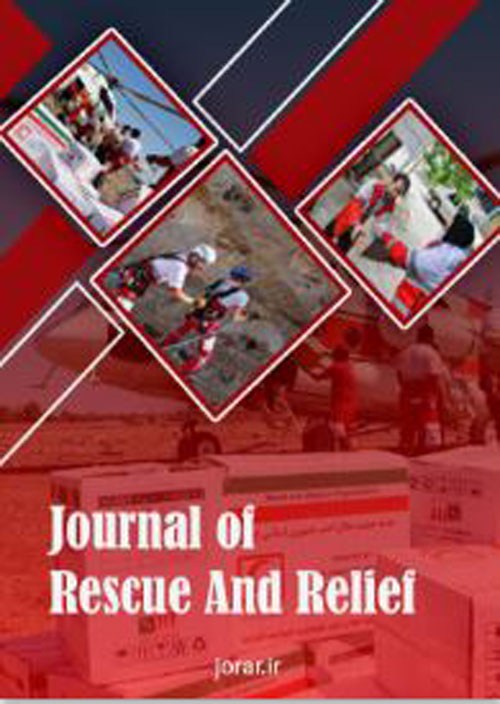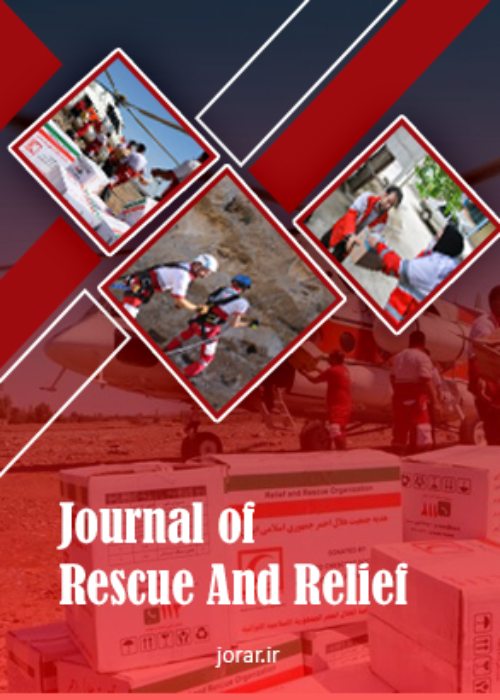فهرست مطالب

Scientific Journal of Rescue Relief
Volume:14 Issue: 4, Winter 2022
- تاریخ انتشار: 1401/10/05
- تعداد عناوین: 8
-
-
Pages 239-249INTRODUCTION
Environmental hazards caused by climate change and urban life prevailing practices have had a much greater impact in recent years than in the past. Aquatic ecosystems are not immune to such threats and their consequences, such as droughts and the emergence of interconnected crises. Since crisis studies are interdisciplinary, the organizational capacity of decision-making entities in urban areas plays a vital role in controlling these complex environmental changes. Therefore, this study aims to investigate organizational resilience as a guiding perspective in the crisis management process emphasizing organizational learning from crisis experience. The objective is to assess the organizational resilience capacity of public and official organizations in Isfahan, Iran, regarding the risks of the drought crisis.
METHODSThis study proposes applying the Delphi method, the Bulls-eye method, and Gray relational analysis based on previous theoretical studies. The analysis begins by entering the initial weight of the Delphi method into the algorithm of this integrated method of weighing the values of uncertain indicators, followed by Gray relational analysis to describe the classification of official and public organizations in Isfahan, Iran. The statistical population consists of experts and professionals active in crisis management in the municipalities of Isfahan. The data of the Gray relational analysis decision matrix were obtained from a valid and structured questionnaire (Cronbach’s alpha=0.79) administered to a sample of 70 individuals with the Delphi method examining the quality of decisions by municipal experts from the 15 districts of Isfahan, who were purposefully selected for sampling. The municipalities were prioritized based on relative organizational resilience capacity.
FINDINGSThe three indicators of investment, specification of roles, and organizational stability showed the highest weight, while the indicators of learning from previous crisis experiences, reconstruction planning, emergency services, and risk insurance coverage had in order the lowest weights. Organizational resilience of studied districts can be defined in three levels: 1) municipalities of districts 6, 5, 8, and 12 had the highest capacity; districts 2, 11, 9, 14, 15, and 4 showed weaknesses in their organizational indicators; and 3) districts 1, 3, 7, 10, and 13 were intermediate between the previous two levels.
CONCLUSIONConsidering that a larger number of areas in Isfahan showed low levels of organizational resilience, the status of organizational resilience in public and formal organizations in Isfahan does not report favorable conditions among the research indicators. Therefore, more attention is required to improve the aforementioned organizational indicators to achieve organizational learning from crisis conditions. Awareness of the level of organizational resilience helps to promote organizational learning, improves the crisis management process, and helps planners and managers to perform better in critical situations.
Keywords: Bulls-eye method, Gray relational analysis, Isfahan municipality, Organizational learning, Organizational resilience, Secondary drought crises -
Pages 250-257Introduction
The use of resilience engineering principles is a commonly used method for the assessment of crisis management in hospitals as a part of the health system. The present study aimed to evaluate crisis management based on the seven principles of resilience engineering in selected hospitals affiliated to Yazd University of Medical Sciences in 2021.
Materials and MethodsIn this study, a crisis management evaluation questionnaire based on the seven principles of resilience engineering in hospitals was used. The reliability and validity of this questionnaire were confirmed by Azadian et al. in a previous study. The required data were collected from administrative and clinical managers and nurses. The mean score of the seven principles was obtained, making it possible to compare crisis management in all three selected hospitals (Shahid Sadoughi, Afshar, and Shahid Rahnamoun) in Yazd.
FindingsThe mean score of resilience engineering principles was determined, and the overall crisis management score of each hospital was determined. The mean scores of crisis management were calculated at 136.53, 135.23, and 132.07 out of a total score of 220 in Shahid Sadoughi, Shahid Rahnamoun, and Afshar hospitals. Nonetheless, the mean score in flexibility and preparedness components in some hospitals was below 0.6 of the total score.
ConclusionThe situation of crisis management in all three hospitals was evaluated to be at a good level. However, some corrective measures were required to be implemented in some components to improve crisis management in all three hospitals. It is necessary to take appropriate measures to enhance the preparedness of the three hospitals in different aspects of crisis management, especially flexibility, to arrive at a more favorable level.
Keywords: Assessment, Crisis management, Resilience engineering, Seven principles, Hospital -
Pages 258-268Introduction
Natural disasters are known as one of the most important factors in the destruction of human settlements. One of the key concerns for urban planners is examining how natural disasters affect human settlements, particularly cities. Earthquake is one of these natural disasters that has always threatened human settlements and can cause a lot of damage and casualties in a short period. Therefore, this study aimed to assess the vulnerability of settlements in District 2 of Tabriz, Iran, against earthquakes.
MethodsThis applied research was conducted based on a descriptive-analytical approach. The primary data of existing documents and maps were collected from related organizations. The analytical hierarchy process model and geographic information system software were used for data analysis.
FindingsTo determine the vulnerability of the texture of District 2 of Tabriz, such indicators as the distance from the fault, slope percentage, groundwater levels, building age, building materials, building quality, building density, number of floors, plot area, and land use were employed.
ConclusionAccording to the results, 35% of the region was in the high-risk and 25% in the very high-risk areas. In general, it can be said that most of the region (i.e. 60%) was in the area with a high risk of earthquake, and the area with very high risk was mostly in the northern parts of the region, while the southeastern parts of the region were located in low-risk areas.
Keywords: Vulnerability, Earthquake, City tissue, region 2 of Tabriz, GIS -
Pages 269-277INTRODUCTION
This research was conducted with the aim of providing a model of public education based on social participation for the resilience of Tehran's urban society in natural disasters especially earthquakes.
METHODSThis qualitative research was done by Delphi method. About 15 experts and decision-makers in the field of natural disasters and crisis management were selected to participate in the research through a targeted process by using the snowball method.
FINDINGSThe findings showed that the participation of the public including mental and objective participation and having a cooperative spirit can have an impact on public education. In addition, this education is effective on the resilience of the public with social, economic, cultural, and institutional components and can bring the consequences of sustainable development.
CONCLUSIONAccording to the results, the resilience fields such as information and communication infrastructure, physical infrastructure and supportive policies can provide a platform for resilience in the society; however, interveners such as demographic characteristics and geographical characteristics should not be ignored
Keywords: Public education model, Resilience, Social participation -
Pages 278-284INTRODUCTION
The present study aimed to compare the cultural components among the youth in Tehran, Iran with an emphasis on political culture.
METHODSIn this quantitative research, a total of 382 youths aged 18 to 35 were selected using Cochran's sample size formula. Simple cluster and random sampling methods were used in this study. The data of the participants were collected using a researcher-made questionnaire. The reliability of the test was calculated with Cronbach's alpha (0.78).
FINDINGSThe components of political culture, political value, political knowledge, and political attitude were expressed by the respondents as the most important items with a mean of 3.26, 3.35, 3.21, and 3.24, respectively.
CONCLUSIONThe results of the research revealed a significant difference between the level of the political culture of youths in each urban area. In addition, a significant difference was observed in the components of political culture (value, knowledge, and political attitude) according to the urban area (north, south, east, west, and center) of Tehran.
Keywords: Political attitude, Political culture, Political knowledge, Political value, Tehran, Youth -
Pages 288-297INTRODUCTION
The need to carry out the emergency evacuation of people from disaster-affected areas and their transfer to safe areas, in the shortest possible time and with the least number of injured, has made the issue of urban emergency evacuation a complex one in the real world. The complexity of the spatial layout of the courtyards and the presence of a large population within the Shrine, among which vulnerable groups also have a significant share, increase the probability of the population's vulnerability to natural and human disasters. Based on this, the current research was conducted to investigate the vulnerability of the pilgrims of Imam Reza's Shrine during the emergency evacuation caused by the crisis and what measures could reduce the vulnerability.
METHODSThe present applied study was conducted based on a descriptive-analytical method. The required data were collected through documentary-library and field studies methods. The gathered data were analyzed using the Analytic Hierarchy Process model, fuzzy logic, and the Inverse Distance Weighting interpolation method in Arc GIS and Expert Choice software.
FINDINGSThe findings of this study indicated that based on the presented integrated model, which included 7 variables of the length of the route, the number of nodes along the route, the number of nodes in the surrounding space of the settlement, fixed and passing population density, the ratio of the population to the width of the exit door, and distance from buildings, the highest level of a possible vulnerability in the Shrine was related to Rozeh Monavvareh, Goharshad Courtyard, Sheikh Bahaie Sanctuary, the western part of the Great Prophet Courtyard, and Bab-Al-Javad in descending order. The north and northeast parts of the Shrine had a low level of vulnerability for people's exit.
CONCLUSIONThe results of this research showed that the presented model could be used as a suitable model in other religious places. In addition, some measures can be adopted to reduce the vulnerability of pilgrims, including increasing the number and width of the doors, removing obstacles in the place of the doors, and paying attention to the type of activities assigned to different parts of the Shrine.
Keywords: Emergency evacuation, Fuzzy logic, Shrine of Imam Reza, Interpolation method, Vulnerability analysis -
Pages 298-307
Nowadays, human life is full of incidents that have greatly increased the risk. In a society based on altruism, morality dictates that every person who can help others should do so. This point has been descriptively and analytically accepted in the examination of the legal system of Iran and the duty to help has been accepted with all the conditions. The obligation to help is established when a person is exposed to a life-threatening danger and the helper can prevent that or the aggravation of its outcome or the injured person asks for help in an emergency and the helper understands that. In the present study, the importance of the duty to rescue was investigated regarding the legal system of other countries especially those with common law. It is necessary to amend laws in Iran to expand the scope of the duty to rescue by reducing the conditions of that considering the increase in accidents in society.
Keywords: Criminalization, Injured, Refusal, Relief, Rescue


